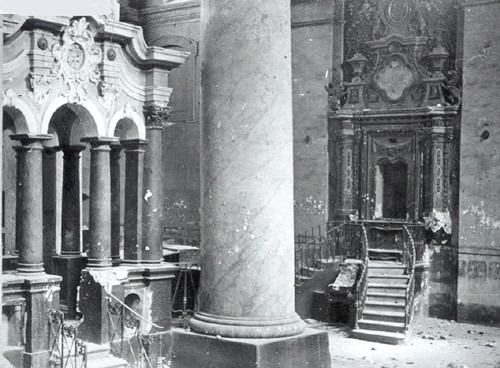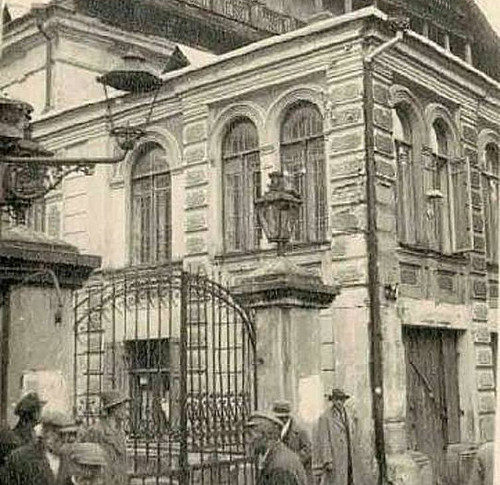 Iran’s Attack on Israel
Iran’s Attack on Israel


8 min read
Cutting edge technology is unearthing fascinating new evidence regarding the Jews of Vilna.
Israeli archeologists are world-renowned for identifying and excavating ancient sites within Israel and beyond, adding to our understanding of life thousands of years ago.
In recent years, some archeologists from the Israeli Antiquities Authority, working with other archeologists from around the world, have been uncovering secrets from a more recent past, namely synagogues and other Jewish buildings in Vilnius, Lithuania, which were destroyed during World War Two by the Nazis, and an escape tunnel used by Lithuanian Jews during the Holocaust. In the process, these scientists have reminded the world that the history of Vilnius is largely the history of its Jews.
Before World War Two, Vilnius (also known as Vilna) was home to one of the largest Jewish communities in Europe. 100,000 Jews called the city home, nearly half the population. Some of the most famous rabbis of the modern era lived in or near Vilnius, including the Vilna Gaon (1720-1797), his student, Rabbi Chaim of Volozhin (1749-1821), who established the famed yeshiva in Volozhin, about 70 miles from Vilnius, and Rabbi Israel Meir Kagan (1838-1933), known as the Chofetz Chaim, who studied and lived part of his life in Vilnius.
 Bimah & Aron Kodesh of the Great Synagogue.
Bimah & Aron Kodesh of the Great Synagogue.
(Thanks to http://www.seligman.org.il)
Known as the “Jerusalem of Lithuania”, Vilnius was home to 105 synagogues and six daily Jewish newspapers. At the heart of this bustling Jewish life was the Great Synagogue of Vilnius. In reality not one synagogue but 12, the Great Synagogue was built in a grand 17th Century lavish Renaissance-Baroque style. In the middle was the “Great” synagogue, a huge hall used to study Torah and host communal events. Around this grand building were 12 synagogues, Jewish schools, mikvahs, the Jewish community council building, the famous Strashun Library, and space for kosher vendors.
 Vilna Synagogue Facade, the Strashun Library and the Shops on Zydu Street
Vilna Synagogue Facade, the Strashun Library and the Shops on Zydu Street
For 300 years this vast complex was the heart of Lithuanian Jewry, until German soldiers captured the city in June 1941, ransacked and burned the Great Synagogue and all its surrounding Jewish buildings. German soldiers and local collaborators killed 95% of Lithuania’s Jews.
 The Aron Kodesh of the Great Synagogue of Vilna
The Aron Kodesh of the Great Synagogue of Vilna
In 1944, when the Soviet Army captured Vilnius, a modern school was built atop the Great Synagogue’s ashes. “My parents told me that my school was on top of the synagogue but no one knew where,” explained Amit Belaite, a member of the European Union of Jewish Students. For decades, the spot where the Great Synagogue and its surrounding buildings once stood was unknown and largely unremembered.
In 2015, a team led by Dr. Jon Seligman of the Israel Antiquities Authority and Prof. Richard, Director of the Maurice Greenberg Center for Judaic Studies at the University of Hartford, set out to uncover the site of the synagogue, approaching the site the way they explored archeological ruins. They conducted a Ground Penetrating Radar survey and in July 2015, announced they had located the underground ruins of the buildings.
The researchers have uncovered some ground-breaking new evidence of Jewish history in the region.
“We felt tremendous excitement when the radar located signs of possible remains of the synagogue,” Dr. Seligman explained at the time. Drs. Seligman and Freund quickly planned an archeological dig of the area and started recruiting scientists, archeologists and volunteers from Israel, Lithuania, and Jewish communities around the world.
“The goal is to ensure that the Jewish heritage of Vilnius is understood as an important and inseparable part of the Lithuanian and Jewish heritage. It’s important that the site be preserved forever, for the benefit of everyone who arrives there in the future,” Drs. Seligman and Freund promised. Nearly two years on, the researchers have uncovered some ground-breaking new evidence of Jewish history in the region.
At the site of the Great Synagogue, researchers in 2016 unearthed part of the buildings for the first time in decades. Treating the site as an archeological dig, using vast screens to sift earth and uncover artifacts, volunteers from Britain, Canada, Israel, Lithuania, and the United States revealed part of a staircase and underground passageways. As researchers continue to excavate the site, Lithuania’s government weighs plans to rebuild and memorialize part of the synagogue.
Having identified underground ruins in Vilnius, Dr. Seligman and Prof. Freund decided to use their radar equipment to explore a nearby site – the Ponar Forest (today known as Paneriai), where Jews were said to have dug an escape tunnel, using only their bare hands, under the very noses of their Nazi captors. Although 11 surviving Jews insisted that the tunnel in Ponar had saved their lives, over the years many people became skeptical of this fantastic-sounding story, dismissing it as a myth. Without the physical evidence of the tunnel, whose location had long been lost, even some sympathetic people had trouble believing the survivors' account.
“I took them seriously but not literally,” Prof. Freund explained of survivors’ insistence that this tunnel was fact. “Without physical evidence, we have a lot of people that are skeptical about all of these stories. They want to see the evidence.” In 2004, the entrance to the tunnel had been discovered, but the tunnel itself could not be mapped. Prof. Freund and his team set out to provide that evidence and let the world know what occurred in the infamous Ponar Forest outside Vilnius.
Between 1941 and 1944, Nazi SS soldiers and Lithuanian collaborators shot 100,000 people, including 70,000 Jews, in the Ponar forest, throwing their bodies into hastily dug pits. In 1944, hoping to hide evidence of war crimes, the Nazis tried to erase evidence of the massacre. They brought in Jewish prisoners from the Stutthof concentration camp. With their legs in chains, these prisoners were made to dig up the mass graves, exhume the bodies, and burn them. Called the “Burning Brigade”, it was obvious to these prisoners that once their work was completed they, too, would be killed and all evidence of their murders erased.
One prisoner, Isaac Dogim, was moving decomposing bodies when he recognized the necklace he’d given his wife for their wedding on one of the corpses. He’d uncovered her body and was now tasked with burning her remains. Horrified, Mr. Dogim planned an audacious escape.
Each night, the prisoners were kept in one of the pits that had until recently been occupied by the murdered Jews. The work of burning the bodies went on for months, and for 76 nights, Mr. Dogim and his fellow prisoners dug a 112-foot long secret tunnel ten feet underground, leading from the pit they slept in. They used their bare hands and crude tools for the digging. Finally, on the night of April 15, 1944, 40 prisoners filed of the chains around their legs and escaped through the tunnel. The tunnel was narrow, just wide enough for one man at a time. Guards quickly discovered the escape, and shot most of the prisoners, but 11 managed to escape into the surrounding forest.
Using Electrical Resistivity Tomography, a way of examining underground structures used in mineral and oil exploration, Prof. Freund, Dr. Seligman and their team found the tunnel and its exit. (The tunnel entrance had been discovered by a Lithuanian archaeologist in 2004.) “It is a very important discovery, because this is another proof of resistance of those who were about to die,” explains Markas Zingeris, Director of the Vilna Gaon Jewish State Museum in Vilnius.
Today, the Jewish legacy of Lithuania is under siege. Some members of Lithuania’s 5,000 strong Jewish community have reacted with alarm at Government plans to rebuild part of the Great Synagogue complex, fearing the plans are an excuse to turn the site into a real estate development.
The Lithuanian government is planning to build a new convention center on the site of Vilnius’ old Jewish Cemetery.
The Lithuanian government is planning to build a new Vilnius Convention Center on the site of Vilnius’ old Jewish Cemetery. The cemetery, which opened in the 15th century and is the final resting site of thousands of Jews, including some of the greatest Jewish scholars who made Vilnius known as the “Jerusalem of Lithuania”, has been repeatedly desecrated since World War Two. The proposed convention center would be the final insult that erased all trace of this massive cemetery.
During Soviet rule of Lithuania, the gravestones were all stolen, many used as building materials in buildings in and around Vilnius. (In 2015, Lithuania’s Chief Rabbi called on the Evangelical Reformed Church in Vilnius to remove the 30 foot long staircase constructed of Jewish headstones that leads to the main entrance of the denomination’s largest church in the capital.) A sports arena was built in the middle of the cemetery on a base that includes human remains. Now, with European Union funding, the Lithuanian government has announced the $25 million center will sit atop the cemetery.
Local residents have started a petition to get the location of the proposed convention site changed. (Click here to sign the petition.)
As the Jewish history in Vilnius is increasingly erased and forgotten, the efforts of Israeli, American and other archeologists to uncover and preserve Jewish history is more important than ever.
